The Photoresist Chemical Market is estimated to be valued at USD 3.5 billion in 2025 and is projected to reach USD 5.0 billion by 2035, registering a compound annual growth rate (CAGR) of 3.6% over the forecast period.
The Photoresist Chemical market is witnessing substantial growth driven by the increasing demand for advanced semiconductor manufacturing and precision microfabrication processes. The market expansion is largely influenced by the rising adoption of high-performance electronic devices and the ongoing miniaturization of semiconductor components. Continuous advancements in photolithography technologies have enhanced the need for specialized photoresist chemicals, enabling higher resolution, better pattern fidelity, and improved process reliability.
Additionally, the growing investment in research and development by semiconductor manufacturers to achieve faster, smaller, and more efficient chips has further propelled market demand. Increasing deployment of consumer electronics, communication devices, and industrial automation systems has created consistent demand for microelectronics, which relies heavily on photoresist chemicals.
The market is also supported by stringent quality and performance standards that ensure the adoption of high-purity and reliable photoresist materials With ongoing innovations and the push toward next-generation semiconductor nodes, the Photoresist Chemical market is expected to maintain a steady growth trajectory in both mature and emerging regions.
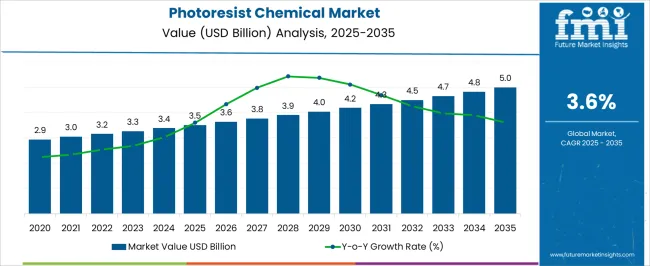
| Metric | Value |
|---|---|
| Photoresist Chemical Market Estimated Value in (2025 E) | USD 3.5 billion |
| Photoresist Chemical Market Forecast Value in (2035 F) | USD 5.0 billion |
| Forecast CAGR (2025 to 2035) | 3.6% |
The market is segmented by Product Type, Spectral Line Size, and End Use Applications and region. By Product Type, the market is divided into Positive and Negative. In terms of Spectral Line Size, the market is classified into ArF Immersion, G-Line, I-Line, KrF, and ArF Dry. Based on End Use Applications, the market is segmented into Microelectronics, Sand Carving, Fabrication Of Printed Circuit Boards, and Others. Regionally, the market is classified into North America, Latin America, Western Europe, Eastern Europe, Balkan & Baltic Countries, Russia & Belarus, Central Asia, East Asia, South Asia & Pacific, and the Middle East & Africa.
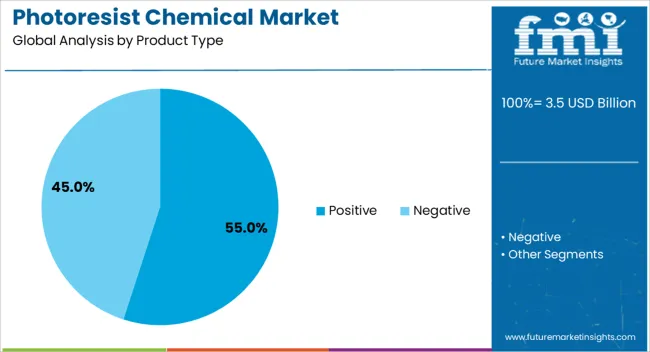
The positive product type segment is projected to hold 55.0% of the Photoresist Chemical market revenue share in 2025, making it the leading product type. This dominance is driven by its superior performance in enabling precise patterning on semiconductor wafers, which is critical for modern microelectronics manufacturing.
Positive photoresists offer high resolution, predictable behavior under exposure, and easier process control, which improves yield and consistency in complex chip production. The segment has also benefited from continuous improvements in chemical formulation, enhancing sensitivity, adhesion, and thermal stability, which are essential for advanced lithography applications.
Additionally, positive photoresists are compatible with a wide range of photolithography equipment and processes, making them highly versatile for semiconductor fabrication The growing emphasis on miniaturization and high-density integrated circuits has reinforced the adoption of positive photoresists, ensuring their leading position in the market.
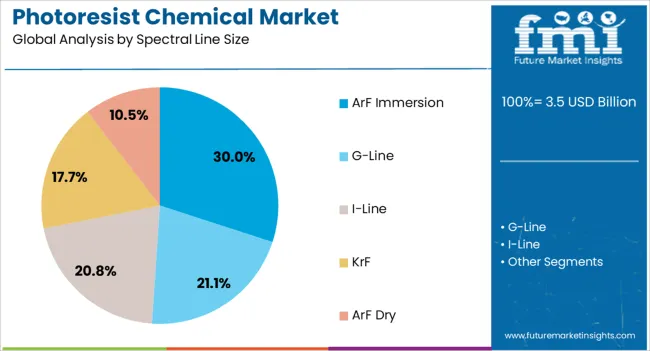
The ArF immersion segment is expected to capture 30.0% of the Photoresist Chemical market revenue share in 2025, establishing it as a leading spectral line size. The growth of this segment is driven by the demand for ultra-fine patterning required in advanced semiconductor nodes. ArF immersion lithography enables higher resolution and precise feature definition, which is critical for producing smaller and more powerful chips.
The segment has benefited from technological innovations that improve depth of focus, reduce defects, and enhance throughput in wafer fabrication. Increasing production of high-performance microelectronics, memory devices, and integrated circuits has created a significant need for ArF immersion photoresists.
The growing adoption of smart devices and advanced electronics has further propelled this segment, as manufacturers prioritize yield, efficiency, and device performance Continuous investments in semiconductor fabrication facilities and next-generation lithography equipment continue to drive the prominence of the ArF immersion segment.
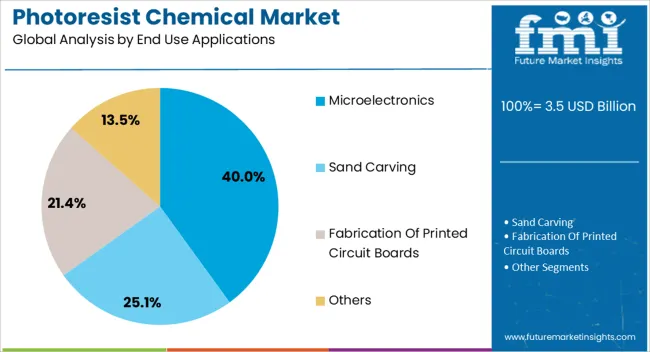
The microelectronics end-use application segment is anticipated to account for 40.0% of the Photoresist Chemical market revenue in 2025, making it the leading application area. This growth is fueled by the rising demand for integrated circuits, memory chips, and advanced semiconductor devices used in consumer electronics, telecommunications, and industrial automation.
Photoresist chemicals play a critical role in ensuring precise patterning, high resolution, and reliable performance of microelectronic components. The segment has been driven by the increasing complexity of semiconductor devices and the push toward smaller nodes, which require high-quality, specialized photoresist materials.
Additionally, the proliferation of IoT devices, AI-enabled electronics, and 5G infrastructure has significantly increased the demand for microelectronics, further supporting the growth of this segment With continued technological advancements and ongoing investment in semiconductor manufacturing capabilities, the microelectronics segment is expected to maintain its leading market position.
Novel Patterning Techniques to Transform the Global Market
Key players are investing in new methods to develop microcircuits, beyond conventional photolithography. New patterning techniques include directed self-assembly (DSA) uses the self-organization of molecules to develop intricate patterns. New photoresists are being designed especially for DSA compatibility.
Another method to develop photolithography includes nanoimprint lithography (NIL), which uses mold to press patterns onto a substrate. Although this method is not new, advancements in photoresists are facilitating higher-resolution patterning with NIL.
Manufacturers are Moving Toward Sustainability
Traditional photoresist chemicals contain harsh chemicals and solvents that pose health and environmental risks. As a result, pushing the trend of sustainability. Researchers can be seen experimenting with photoresists extracted from natural materials like lignin and cellulose.
Such offers potentially lower environmental impact and provide a more sustainable alternative. Additionally, another focus area of players includes the development of photoresist formulations that use less hazardous solvents. Thereby, improving worker safety and simplifying waste disposal.
Challenges Prevalent in the Photoresist Chemical Market
Fluctuations in the raw materials, transportation costs, and energy are key factors that are impacting the industry’s expansion. This volatility in prices is influencing the manufacturers’ profitability and the industry’s entire cost structure. To effectively deal with these challenges, players must closely observe and manage costs to ensure market competitiveness.
Global photoresist chemical sales rose at a CAGR of 2.4% from 2020 to 2025. Over the forecast period, the industry is projected to expand at a 3.6% CAGR.
During the historical period, the growth pace of the market was sluggish. However, as the years roll by, the growth is expected to accelerate. A chief driver is the demand for semiconductors in the electrical and electronics industry. The surging adoption of dynamic display technology is expected to further stimulate the photoresist chemical industry.
Photoresist chemicals are available in various types including wet chemicals, low-k dielectric, silicon wafers, CMP slurries, PCB laminates, etc. Their wide variety is fueling their applications across various industries.
Apart from this, considerable research and development in this sector and end use industries are projected to fuel innovations. This is further creating new demand areas and boosting the manufacturers' revenues.
Photoresist electronic chemicals demand is also increasing in advanced packaging technologies, like 3D packaging, wafer-level packaging, and fan-out packaging. These packaging techniques need precise patterning as well as lithography processes, where photoresist materials play a critical role in defining the interconnect and circuitry.
According to the latest statistics, the photoresist chemical sector is observing snail-paced growth in the United States and the United Kingdom. In Asia Pacific except Japan, the growth of the photoresist chemical sector is projected to be consistent due to heightened consumer demand for consumer electronics.
| Countries | CAGR 2025 to 2035 |
|---|---|
| United States | 2% |
| United Kingdom | 1.4% |
| China | 4.1% |
| India | 5.4% |
| Japan | 1.5% |
The photoresist chemical industry in the United States is stretching at a 2% CAGR over the forecast period. This can be attributed to the expanding electronics and electrical industry in the United States, which played a key role in enhancing the regional market’s demand.
The presence of various Integrated Device Manufacturers (IDMs) and semiconductor manufacturers is rising across the country. These manufacturers consistently invest in research and development activities, fabrication facilities, and advanced semiconductor technologies. Therefore, owing to these factors, the industry is projected to rise in the United States.
India is projected to experience significant growth over the forecast period, with a CAGR of 5.4%. Rising demand for smartphones, wearable devices, and other electronic devices propel the demand for photoresist chemicals.
The application of megatrends like IoT and 5G and the execution of AI technology throughout various industries are chief factors propelling the demand for photoresist chemicals.
The rising acceptance of nanotechnology has further fueled the utilization of nanodevices. Thus, creating significant prospects for photoresist chemical manufacturers.
The photoresist chemical sector in Japan is expected to surge at a 1.5% CAGR over the forecast period. The electronics and electrical industry in the country is encouraging the sales of photoresist chemicals. The component is used in the production of video cameras, computers, compact discs, fax machines, photocopiers, cell phones, and different other main computer components.
The manufacturing of servers, displays, storage equipment, etc. is predicted to surge steadily over the forecast period, as per the Japan Electronics and Information Technology Industries Association (JEITA). Additionally, the advanced manufacturing sector is recognized as a lucrative sector. This sector includes smart factories and IoT-related technologies.
This section gathers insights about the leading performers in the photoresist chemical industry. Presently, positive photoresists in the product type category are gaining significant appeal, registering a share of 62.4% in 2025.
Under the end-use application category, the microelectronics segment is expected to relish prominence over the forecast period. In 2025, this segment is anticipated to obtain a 73.9% share.
| Segment | Positive Photoresist (Product Type) |
|---|---|
| Value Share (2025) | 62.4% |
The positive photoresist segment is projected to acquire a massive value share in 2025. Positives are gaining significant popularity in the microelectronics industry as the industry is increasingly using smaller geometry designs for process controllability.
The positive photoresist materials are extensively used in high-resolution applications where fine patterns and features are required. Key players are investing in the research and development of positive photoresist designs to achieve tighter line widths and smaller sizes. Thus, facilitating the production of advanced semiconductor devices.
| Segment | Microelectronics (End Use Application) |
|---|---|
| Value Share (2025) | 73.9% |
The microelectronics segment is projected to obtain notable value share in 2025. Increasing demand for consumer electronics, technologies like AI and IoT, and high-performance devices is fueling the demand for chips that power them. Photoresists have a critical role in creating delicate circuitry on these chips.
The emerging trend of miniaturization in electronics is boosting the demand for precise patterning on chips. New formulations of photoresists are being created to meet these challenges.
Thus, facilitating the development of smaller, denser circuits. Furthermore, advanced packaging techniques such as 3D integration depend on specialized photoresists for precise patterning. Growing demand for smaller, more powerful devices is predicted to fuel demand for critical patterning chemicals.
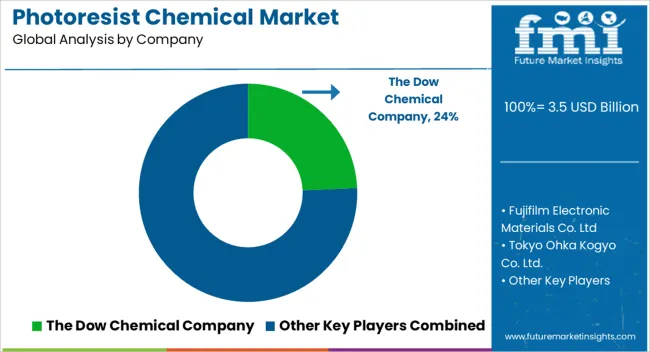
Key players in the photoresist chemicals industry are focusing on investing in research and development to develop next-generation photoresists. This includes the development of extreme ultraviolet (EUV) lithography, which is indispensable for photoresists, and miniaturization, compatible with advanced packaging techniques.
Research is also ongoing for the development of eco-friendly photoresist chemicals. The intent is the search for alternatives to avoid the usage of compounds that raise concerns about environmental protection, safety, and health.
Players are further strategically zeroing in on high-growth segments within microelectronics like those driven by 5G, AI, and the Internet of Things (IoT). Developing photoresists particularly suited for these applications is giving them an edge. Additionally, players are focusing on the development of advanced photoresist materials to boost market progress.
Industry Updates
Based on product type, the sector is divided into positive and negative.
By spectral line size, the market is segmented into g-line, i-line, KrF, ArF immersion, and ArF dry.
Different end use applications for photoresist chemicals include microelectronics, sand carving, and fabrication of printed circuit boards, among others.
The report analysis details the sales prospects of photoresist chemicals across North America, Europe, Asia Pacific, the Middle East and Africa, and Latin America.
The global photoresist chemical market is estimated to be valued at USD 3.5 billion in 2025.
The market size for the photoresist chemical market is projected to reach USD 5.0 billion by 2035.
The photoresist chemical market is expected to grow at a 3.6% CAGR between 2025 and 2035.
The key product types in photoresist chemical market are positive and negative.
In terms of spectral line size, arf immersion segment to command 30.0% share in the photoresist chemical market in 2025.






Full Research Suite comprises of:
Market outlook & trends analysis
Interviews & case studies
Strategic recommendations
Vendor profiles & capabilities analysis
5-year forecasts
8 regions and 60+ country-level data splits
Market segment data splits
12 months of continuous data updates
DELIVERED AS:
PDF EXCEL ONLINE
Photoresist Electronic Chemical Market Size and Share Forecast Outlook 2025 to 2035
Photoresist and Photoresist Ancillaries Market Size and Share Forecast Outlook 2025 to 2035
Photoresist Stripper Market Analysis - Size, Share, and Forecast 2025 to 2035
Chemical Dosing Equipment Market Size and Share Forecast Outlook 2025 to 2035
Chemical Filling System Market Size and Share Forecast Outlook 2025 to 2035
Chemical Absorbent Pads Market Size and Share Forecast Outlook 2025 to 2035
Chemical Indicator Inks Market Size and Share Forecast Outlook 2025 to 2035
Chemical Boiler Market Size and Share Forecast Outlook 2025 to 2035
Chemical Hardener Compounds Market Size and Share Forecast Outlook 2025 to 2035
Chemical Anchors Market Size and Share Forecast Outlook 2025 to 2035
Chemical Peel Market Size and Share Forecast Outlook 2025 to 2035
Chemical Protective Gloves Market Size and Share Forecast Outlook 2025 to 2035
Chemical Injection Pump Market Size and Share Forecast Outlook 2025 to 2035
Chemical Liquid Hydrogen Market Size and Share Forecast Outlook 2025 to 2035
Chemical Sensors Market Size and Share Forecast Outlook 2025 to 2035
Chemical Resistant EVA Film Market Size and Share Forecast Outlook 2025 to 2035
Chemical Resistant Fabrics Market Size and Share Forecast Outlook 2025 to 2035
Chemical Resistant Coating Market Size and Share Forecast Outlook 2025 to 2035
Chemical Distribution Market Size and Share Forecast Outlook 2025 to 2035
Chemical & Petrochemical IECS Market Size and Share Forecast Outlook 2025 to 2035

Thank you!
You will receive an email from our Business Development Manager. Please be sure to check your SPAM/JUNK folder too.
Chat With
MaRIA